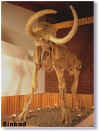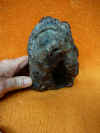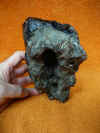You are on Mammoth Fossils, Page 2
Contents: Mammoth - SOUTH CAROLINA, FLORIDA, SOUTH DAKOTA: Tusk specimens, leg pieces, teeth pieces; Photo Gallery South Dakota; Mastodon ivory, teeth (South Carolina); Mammoth leg bones (Florida); Fossil Stegodon (Indonesia), Fossil Gomphotherium elephant tooth (South Carolina)
TABLE OF CONTENTS IS ON PAGE 1
Click to: Mammoth Page 1 Page 3
|
SOUTH CAROLINA
WOOLLY & COLUMBIAN MAMMOTH |
|
Woolly mammoth display at the State Museum in Columbia SC
|
|
Picture of "Sinbad", a life-size model of a Columbian Mammoth found at Mammoth Site, Hot Springs, South Dakota! (picture credits to them, the great photography is much appreciated).
|
|
MASTODON Fossil IVORY pieces
found on South Carolina shores |
||
 #WM-269-I $10 |
 #WM-269-K $10 |
|

#WM-269-N $10 |

#WM-269-P $10 |
|
|
FLORIDA
Ball joints, Mastodon |

#WM-275-A $26 |
| STEGODON |
Stegodon tusks and tooth, Indonesia Similar to mammoth  Stegodon sp. Early Pleistocene Southeast Asia At the beginning of the Late Pleistocene, Southeast Asia was a continent rather than a series of archipeligos. Fluctuating sea levels have alternately submerged and exposed large areas of land numerous times over the past 2 million years. Fossils found throughout Southeast Asia, such as Stegodon specimens, illustrate these geologic changes, as the same species are found from Indonesia to Malaysia to the Philippines. Stegodon specimens are exceedingly rare. 1- to 2-million-year-old member of the Elephantidae subfamily, this genus is considered the ancestor of elephants, mastodons and mammoths. The genus Stegodon, from the Greek, stegos, meaning roof, and odon, meaning tooth (referring to the step ridges on the molar tooth) originated in the Late Miocene in Asia. |
.JPG) .JPG) .JPG) .JPG) .JPG) .JPG) .JPG) .JPG) #WM290-1 Stegodon tusk, stabilized Measures 14" long x 2-3/4" diameter Weight: 5 pounds 1.3 ounces $650 SOLD |
.JPG) .JPG) .JPG) .JPG) .JPG) .JPG) #WM290-2 Stegodon tusk, stabilized, still has ocean concretion on it Measures 12" long x 2-3/4" largest diameter Weight: 3 pounds 8.5 ounces $600 SOLD |
.JPG) .JPG) .JPG) .JPG) .JPG) .JPG) .JPG) .JPG) #WM290-10 Stegodon tooth, complete and stabilized Measures 9-1/4" long x 3" tall x 3-1/2" deep Weight: 3 pounds 11.5 ounces $599 |
 Click here to see Stegodon bone bead earrings Starts with series #DP3-600 - pg 3 Dino Bone & Poop Jewelry |
| GOMPHOTHERIUM |
|
Fossil GOMPHOTHERIUM TOOTH
(extinct elephant species with 4 tusks), tooth found in South Carolina, 4-5 million years old Gomphotherium (pronunciation: gom-fo-THEER-ee-um) ("Welded Beast") is an extinct genus of proboscid, which lived during the Early Miocene & Pliocene Eras of Europe (France, Germany, Austria), North America (Kansas), Asia (Pakistan) and Africa (Kenya). The10 ft tall creature, also known as Trilophodon or Tetrabelodon, resembled a modern elephant but had FOUR tusks instead of two: two on the upper jaw and two on the elongated lower jaw. The lower ones are parallel and shaped like a shovel and were probably used as such. Unlike modern elephants, the upper tusks were covered by a layer of enamel. Compared to elephants, the skull was more elongated and low. These animals probably lived in swamps or near lakes, using their tusks to dig or scrape up aquatic vegetation. In comparison to earlier proboscids, Gomphotherium had far fewer molars; the remaining ones had high ridges to expand their grinding surface. A complete skeleton of Gomphotherium has been found a Muhldorf, Germany, in 1971 Artist's rendition of two living Gomphotherium: |
|
Side & ends #WM-299 Found in the Cooper River, South Carolina by a diver. Dimensions 7-1/4" long x 4-3/8" wide x 3-3/4" tall. Weight: 3.6 pounds Superb specimen we have been proud to own. $2200 |
| FULL MAMMOTH TOOTH, North Sea, Holland |
|
Genuine woolly mammoth tooth, excavated from North Sea off Holland, 12" long x 3" wide x 7" high - a single tooth fills the whole back jaw, 25,000 years old. $550.00 SOLD |










































.JPG)
.JPG)
.JPG)
.JPG)
.JPG)
.JPG)
.JPG)
.JPG)
.JPG)
.JPG)
.JPG)
.JPG)
.JPG)
.JPG)
.JPG)
.JPG)
.JPG)
.JPG)
.JPG)
.JPG)
.JPG)
.JPG)
.JPG)
.JPG)
.JPG)
.JPG)
.JPG)
.JPG)
.JPG)
.JPG)
.JPG)
.JPG)
.JPG)
.JPG)
.JPG)
.JPG)
.JPG)
.JPG)
.JPG)
.JPG)
.JPG)
.JPG)
.JPG)
.JPG)
.JPG)
.JPG)
.JPG)
.JPG)
.JPG)
.JPG)
.JPG)
.JPG)
.JPG)
.JPG)
.JPG)
.JPG)
.JPG)
.JPG)
.JPG)
.JPG)
.JPG)
.JPG)
.JPG)
.JPG)
.JPG)
.JPG)
.JPG)
.JPG)
.JPG)
.JPG)
.JPG)
.JPG)
.JPG)
.JPG)
.JPG)
.JPG)
.JPG)
.JPG)
.JPG)
.JPG)
.JPG)

































